By MARK GRUENBERG
PAI Staff Writer

Washington (PAI) — The Trump-appointed Republican majority on the National Labor Relations Board 2-1 ruling on the issue of an “intermittent strike” (a short-term walkout and then a return to work) not only gave a win to anti-worker retail monster Walmart, but seriously curbs workers’ right to strike, the dissenter in the 2-1 ruling says.
In so doing, the board’s sole remaining Democrat, Lauren McFerran said the practical impact is far worse, by taking a weapon – the intermittent strike – out of workers’ hands. “The majority sharply cuts back on the right of American workers — including those who lack unions — to protest their job conditions by striking,” she declared in a long dissent.
Trump named both board members who voted for Walmart, Marvin Kaplan and William Emanuel, a prominent anti-union labor lawyer in Los Angeles before joining the NLRB.
FIRST RULING, INTERMITTENT STRIKES OK
The Labor Board’s administrative law judge (ALJ) said the workers’ two on-day strikes in 2012 – one involving 58 Los Angeles workers and the other involving 100-130 nationwide on “Black Friday” – and another on Black Friday 2013 were intermittent strikes which Labor law protects.
The judge also said workers on OurWalmart’s Ride for Respect bus caravan to the retailer’s annual meeting in Bentonville, Ark., in 2013 were engaged in a traditional protected strike, as the trip took 5-6 days. The workers were, after all, protesting low pay, bad conditions and other workplace ills.
Retaliating, Walmart fired 16 workers and disciplined dozens, including all 29 who only took the ride.
That discipline and the firings are illegal, the ALJ said.
SECOND RULING: GOP MEMBERS SAY ‘NO’
GOPers Kaplan and Emanuel said “no,” and that Labor law protects traditional strikes, not intermittent ones.
“Broadly stated, a genuine economic strike involves employees fully withholding their labor in support of demands regarding their terms and conditions of employment until their demands are satisfied or they decide to abandon the strike,” the Trump-named majority said. “Striking and then returning to work with the intention of striking again is simply not the same.
“Deciding later that circumstances warrant another strike is fundamentally different than planning a strategy to strike, return to work, and strike again for a more damaging effect with less risk.”
RULING WILL HURT WORKERS
McFerran hit the roof. She said the pro-Walmart ruling would hurt other workers.
The majority’s rule “takes a legitimate protest by unrepresented workers, dissatisfied with the working conditions dictated by a giant in the retail industry, and classifies it as an unprotected ‘intermittent’ strike — even though it was buffered by months of strike inactivity, a tiny percentage of the work force participated, and no serious difficulties for store operations resulted,” McFerran noted.
“The majority’s newly expanded view of the intermittent-strike doctrine will also hamstring other nonunion workers who might seek to use work stoppages to raise awareness about their wages and working conditions.”
McFerran added: The majority’s view has no basis in NLRB precedent. “Worse, it undermines what the Supreme Court has called the ‘strong interest of federal policy in the legitimate use of the strike.’”


